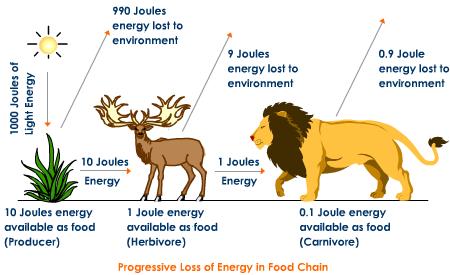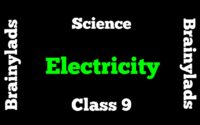Our Environment Class 10 Notes | Science | Term 2 | Questions |
Table of Contents
Our Environment Class 10 Notes | Science | Term 2 |
# Our Environment Class 10 Notes Science
Environment
Our Environment Class 10 Notes : Immediate surrounding where we live is called environment. It can also be referred as the combination of all the physical and biological conditions affecting the responses of living organisms. It basically consists of two components:
Biotic components: It includes living organisms such as fungi, plants and animals.
Abiotic components: It include non-living surrounding such as air, water, temperature, sunlight and soil.
Ecosystem
It is simply the interaction of organisms with each other and with their physical environment.
Types of ecosystem are as follows:-
1.Natural ecosystem: They are self-regulating ecosystem without any major interference by human being.
- Terrestrial Ecosystem It is the one that occurs only earned such as Forest, grassland and desert.
- Aquatic ecosystem It is found in water bodies such as ponds, lakes, rivers and oceans.
2.Artificial ecosystem They are man-made ecosystem that are created and maintained by man such as Garden, Crop Field, Aquarium and Park.
Components of Ecosystem
The two components of ecosystem are as follows:
Abiotic components: Components that consist of inorganic and organic substances and climatic factors such as soil, water, sunlight, temperature, pressure.
Biotic components: Components that consist of living organisms. These are further grouped into producers, consumers and decomposers.
1.Producers: Autotrophs are producers since they produce food. Example green plants, blue green algae. The basic role of producer is to trap solar energy and transform it into food. They also provide atmospheric oxygen to all the animals.
2.Consumers: They consume food prepared by the producers. They are heterotrophs. They are further classified into three categories as discussed below:
- Herbivores- Animals that feed on plants. They are primary consumers. Example deer.
- Carnivores- Animals that prey upon herbivores. They are secondary consumers. Animals which eat secondary consumers are cold. Sherry consumers. Tertiary consumers are eaten by the top carnivores.
- Omnivores- These are those animals that eat both plants and animals.
- Role of consumers
They keep a check on population of producers.
Scavengers eat bodies of dead animals and helps in keeping environment clean.
3.Decomposers – Microorganisms such as bacteria and fungi that break down the complex organic compounds from the bodies of dead plants and animals are simpler substances are known as decomposers.
Role of decomposers:
- They decompose the body of dead plants and animals does acting as decomposing or cleansing agents.
- They could effectively help in recycling the material present in biosphere.
- They maintain the fertility of the soil.
Food chain
It is the feeding interaction between organisms of different population in an ecosystem. It is simply a series of organisms in a community in which one organism consumes other organism in order to transfer food energy. It starts with producers.
It is assumed that more than four consumer in a food chain is unusual since beyond the third consumer level very less amount of energy is left to be transferred to the next trophic level.
In a food chain there is unidirectional flow from of energy from sun to producer and subsequently to series of different types of producers.
Significance of food chain-
- It provides a pathway for transfer of energy from one trophic level to the another.
- It provides information regarding the living components of ecosystem.
- It indicates relationships and interdependence amongst different organisms. It can be said that it helps in understanding the food relationship and interaction among the various organisms in an ecosystem.
Trophic level
These are simply steps in a food chain at which energy transfer takes place from one organism to another. 10% of food taken by one trophic level is available for the next trophic level.
Food Web
The network of several interconnected food chain is usually referred as food web. Food chain in an ecosystem do not operate in isolation and always occur in food web.
Difference between Food Chain and Food Web
| Food Chain | Food Web |
| The sequence of eating and being eaten among the living organisms to transfer energy is called food chain. | It is a system of interconnected food chains. The network of food chains develop a relationship between various organisms. |
| It is having 4- 5 population (trophic level) of different species. | It is having numerous population of various species. |
| It is a part of food web. | It contain many food chains. |
| Food chain do not help in increasing population of endangered species. | The population of endangered species can effectively be increased by food web. |
Ten Percent Law
It was put forth by Lindeman
According to this law only 10% of the energy and bring a particular trophic level is available for the next trophic level.
It is so because most of the energy gets lost in the form of heat in the environment during the energy transfer.
Flow of Energy in an Ecosystem
Energy is required by each organism in order to carry on various activities and for building up and repairment of body tissues. The ultimate source of entire energy used by organisms is the sun.
- It is said that about 1% of the energy of sunlight is captured by the green plants.
- Plants are eaten by herbivores. Only 10% of energy is transferred to the next trophic level where as the 90% is lost as heat and utilized in work.
- Herbivores are written by carnivores and again only 10% energy is transferred.
- The amount of energy goes on decreasing at each trophic level, the food chain consists of three or four steps.
Biological Magnification
The successive increase in the concentration of some chemicals through the various food levels of a food chain is termed as biomagnification.
The amount of toxic nonbiodegradable substances increases with successive trophic levels. Man being on the top in the food chain accumulates maximum concentration of toxic non biodegradable substances in the body.
Waste
The useless left over or discarded material generated in our daily life.
There are basically two types of waste as discussed below
| Biodegradable waste | Non Biodegradable Waste |
| Organic waste which is broken down into simple organic and inorganic compound by decomposers | Waste materials which cannot be broken down into simpler or harmless substances in nature. |
| Example: Cattle dung, paper, wool, wood, domestic waste product, jute bags, fruit peels, vegetable peels. | Example: Plastics, crockery, glass, poly bags, radioactive waste. |
| Harmful effects Foul odour Microbes multiply in dumped wastes Dumps become breeding places for flies, rats |
Harmful effects Chemicals enter food chains and causes biological magnification. Excessive fertilizers, pesticides and chemical waste make soil acidic and alkaline. Pile up at places. |
Managing the Garbage
- Open dumping- solid waste are simply dumped in selected areas in town that creates pollution.
- Recycling- Non biodegradable wastes such as paper glass and metals can be easily recycle in recycling units.
- Landfilling- Waste is dumped in low lying area and compacted by rolling which is then covered by soil.
- Composting- Household waste suggest peeling of fruits and vegetables, leftover food, fallen dead leaves are converted into compost.
- Incineration- Combustible wastes are burnt at very high temperature ( more than 1000°C). Ash obtained after incineration constitutes less than 10% of the total mass of waste. Hospital waste, household waste as well as chemical waste are burnt by this method.
- Reuse- It is the practice of using an item again and again after cleaning.
Ozone Layer
It is a layer of Earth’s atmosphere where ozone is concentrated. It is present at a height of 15 km to 60 km in the upper atmosphere.
It is essential for the existence of life on earth since it absorbs most of the harmful ultraviolet radiations coming from the sun and prevent it from reaching the earth.
The thinning of the ozone layer is referred as ozone depletion.
It is being depleted by air pollutants.
Chlorofluorocarbons are the air pollutants that are mainly responsible for depletion of ozone layer in the stratosphere.
Besides methane and oxides of nitrogen also cause destruction of ozone.
Effects of Ozone Depletion
- Ultraviolet radiation causes skin cancer.
- These causes damage to ice and also can cause increased incidence of cataract disease in eyes.
- This can cause damage to immune system by lowering the body’s resistance to disease.
- In 1987, in an attempt to prevent ozone depletion the United Nations Environment Programme forged an agreement among its member countries to freeze CFC production at 1986 level.
Our Environment Class 10 Questions
Question 1: Why do we say that flow of energy through the food chain is unidirectional?
Answer: The energy in the form of food always transferred from first trophic level to the last trophic level of a food chain. The energy never flows back in the reverse manner that is from the last trophic level to the first trophic level, so we can say that the flow of energy is unidirectional through the food chains.
Question 2: It is generally observed the domestic wastes are decomposed in the bylanes of residential colonies. Suggest some suitable ways to make people realize that the improper disposal of waste is literally harmful to the environment.
Answer: When the domestic waste is decomposed by the action of microorganisms then it becomes the breathing place of flies and mosquitoes. Flies and mosquitoes are the carrier and vector of many dangerous diseases. Show some poster related to the spread of such disease can be pasted on the walls in public place in order to aware people.
Question 3: Explain how does biomagnification affect human health?
Answer: As human being is at the last trophic level of its food chain. Does harmful chemicals enter into human body in the maximum quantity and does damage our internal body organs and causes many types of diseases in our body.
Question 4: What are the destructive effect caused by the chlorofluorocarbons in the atmosphere?
Answer: Chlorofluorocarbons deplete the ozone from the ozone shield that results in the increase in the passage of the harmful ultraviolet radiations to the earth.
Question 5: What are decomposers? What will be the consequence if there would be the absence of decomposers in the ecosystem?
Answer: Decomposers break down the complex organic substance of garbage, dead plants and animals into the simpler in organic substances that go into the soil and are used up again by the plants. In the absence of decomposers recycling of material in the biosphere will not take place.
Question 6: What would happen if all the organism at any particular trophic level are killed?
Answer: If we kill all the organisms in one trophic level then transfer of food energy to the next level will stop. Moreover there will be an overpopulation of individuals belonging to the previous trophic level. The organisms of the higher trophic level will also died due to lack of food. Hence it would directly result in imbalance in the ecosystem.
# Our Environment Class 10
Do share this post if you liked Our Environment Class 10 Notes. For more updates, keep logging on BrainyLads.




